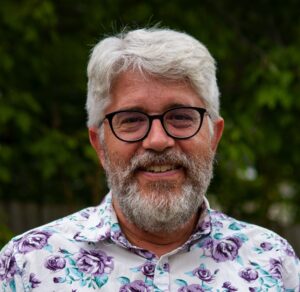Amid the climate crisis, Douglas Day Kaufman finds wild, grounded hope in the gospel of all creatures — in the tiny Caddisfly larva and in the body of Christ.
This blog is part of the ongoing Learn, Pray, Join: Climate Justice: Seeking Shalom series. Lea la versión en inglés aquí.
 Douglas Day Kaufman is the executive director of Anabaptist Climate Collaborative, which puts the gospel of all creatures into practice through student and congregational programs. He was pastor of his home congregation, Benton Mennonite Church, in Goshen, Indiana, for 23 years. He is a graduate of Bethany Christian Schools, Goshen College and Anabaptist Mennonite Biblical Seminary, and he was part of the Toronto Mennonite Theological Centre, while receiving his Master of Theology in Ecology at the University of Toronto.
Douglas Day Kaufman is the executive director of Anabaptist Climate Collaborative, which puts the gospel of all creatures into practice through student and congregational programs. He was pastor of his home congregation, Benton Mennonite Church, in Goshen, Indiana, for 23 years. He is a graduate of Bethany Christian Schools, Goshen College and Anabaptist Mennonite Biblical Seminary, and he was part of the Toronto Mennonite Theological Centre, while receiving his Master of Theology in Ecology at the University of Toronto.
Doug’s most recent essay on the gospel of all creatures appears in “Evangelizing All Creatures: Pastoral Ecology as Mission” in “Hope for Creation: Missional Responses to Environmental and Human Calamities,” edited by Jonathon Bonk, et al, William Carey Publishing, 2024. It is also published in Korean.
_________________________________________________
Some years ago, I spoke with Mark Stege, a colleague from the Marshall Islands, about climate and faith. Once known for being ground zero for U.S. nuclear testing, today the Marshall Islands’ land is disappearing under rising seas. For them, a major challenge is preserving their culture, as forced migration spreads their people across the globe.
Mark told me about speaking to his Catholic priest, who told him that God would not allow the Marshall Islands to disappear. I had been studying climate change denial, but this was a new version for me. Usually, proponents of climate change denial want to escape the United States’ culpability for having the highest greenhouse gas emissions in history. But this Marshallese priest had likely done little to contribute to the problem. He did not want to see himself as a victim of climate disruption.
But the message is the same: God will somehow stop climate change. By now, it has been established by science and observable data that additional greenhouse gasses are causing a warming planet, which causes more intense heat waves, longer droughts, more flooding, sea level rise, more intense storms, and on and on.
In my understanding of the Bible, especially the Hebrew prophets, we suffer the natural consequences of our sin. We live in a world in which colonization, white supremacy and endless wars keep the world from living into the reign of God. And if God was going to stop climate change, why not do it sooner, since so many have already suffered the losses of their homes and lives because of disasters related to climate change.
In my understanding of the natural world, God has established certain patterns that science reveals to us.
So if God does not miraculously rescue us from climate change, how does God work?
I find God at work in the Caddisfly larva.
I first came to know Caddisfly larvae because of their attendance at our baptismal services. Since they are so small, at first, I didn’t even know they were there.
When we started baptizing people in the Elkhart River, we learned that sometimes there is too much manure for a safe baptism. So I became a Hoosier Riverwatch volunteer and led a group that would test the water several times each year.
While that water testing included chemical tests, it also included biological sampling, to check the biodiversity of the river. This is how I discovered the myriad of creatures that make their homes there. Before this, the life teeming in the river bottom was invisible to me.
In the midst of the climate crisis, I find hope in these little creatures. These creatures taught me the good news of God.
As I was reevaluating baptismal theology, I discovered the early Anabaptist teaching of the “gospel of all creatures.” Hans Hut critiqued Martin Luther’s view on the cross of Christ as a one-time event that happened in the past, because he saw it as an ongoing process experienced in creation. Hut wrote:
“The gospel of all creatures is about nothing other than simply Christ the crucified one. But not only Christ the Head was crucified, but rather Christ in all his members. This Christ is what is preached and taught by all creatures. The whole Christ suffers in all members.”
Christ is present in all creation, taking the suffering that is so widespread in all creation and redeeming all creation, turning crucifixion suffering into resurrected joy.
So when it comes to hope in the midst of the creation crisis, I do not find it in the optimistic idea that we will somehow solve the crisis by force of will or voting the right way — though both voting and willing ourselves to do the right thing are good. Nor do I believe in a God who magically prevents us from suffering the natural consequences of our abuse of creation.
No, I find hope in collaborating with the Spirit’s suffering and redeeming presence throughout all creation and with all creatures.
What kind of hope might we call this?
I often call it a grounded hope. One reason for this is that the soil is the place, as soil scientist Rattan Lal once said, where resurrection happens regularly. Soil, which includes many living things, like fungi and bacteria and the tiniest of insects and arthropods, is always in the process of taking death and turning it into new life.
Another good word for it is a wild hope. God has created this world so that she leans into life and abundance and creativity, even in the midst of death and scarcity.
My favorite hymn in the Voices Together hymnal is “There’s a Wild Hope in the Wind” by Lora Braun (828). Writing while facing cancer, she wrote: “The future is dim, but we want to live into a wild, wild hope.” The song is so beautiful and poignant for me that only recently have I been able to sing it without crying, though the tears almost emerge as I write this.
So I seek a hope that collaborates with the creator and the creation, a hope that recognizes the challenges but also knows there is joy to be found. This, at least, is my testimony.

As followers of Jesus, we seek God’s dream of shalom for all people and all of creation, including our climate. Shalom requires that we seek justice and healing for our relationships with God, with one another and with the earth that sustains us.
You are invited to get involved with Learn, Pray, Join: Climate Justice: Seeking Shalom.
Support Mennonite Church USA’s Peace and Justice Initiatives by giving here.
The views and opinions expressed in this blog belong to the author and are not intended to represent the views of the MC USA Executive Board or staff.
Interested in submitting a blog for Menno Snapshots? Please see our blog guidelines here.

